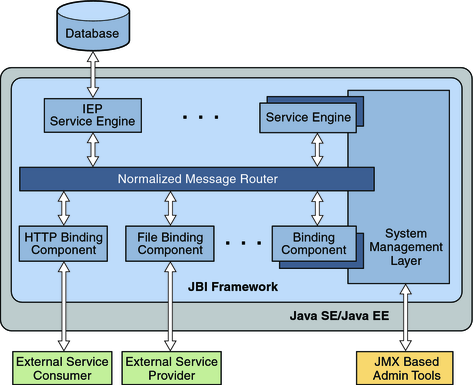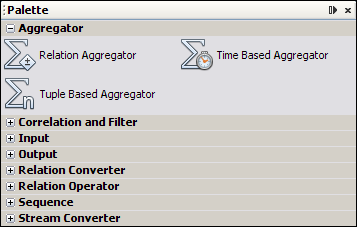| Skip Navigation Links | |
| Exit Print View | |

|
Oracle Java CAPS Intelligent Event Processor (IEP) User's Guide Java CAPS Documentation |
| Skip Navigation Links | |
| Exit Print View | |

|
Oracle Java CAPS Intelligent Event Processor (IEP) User's Guide Java CAPS Documentation |
Designing Intelligent Event Processor (IEP) Projects
Creating an Intelligent Event Processing Module Project
To Create an Intelligent Event Processing Module Project
To Add an Event Processor to the Project
Adding and Configuring IEP Operators
To Add IEP Operators to an Event Processor
To Configure IEP Operators in an Event Processor
Disabling the Generation of Bindings and Services
To Disable the Generation of Bindings and Services
Creating and Deploying the Composite Application Project
To Create a Composite Application Project
To Add the IEP Module Project to the Composite Application Project
To Define the Binding Components and Connections
To Deploy the Composite Application Project
IEP Operator Inputs and Outputs
To Create a Relation Aggregator Operator
To Create a Time Based Aggregator Operator
To Create a Tuple Based Aggregator Operator
Correlation and Filter Operators
To Create a Relation Map Operator
To Create a Stream Projection and Filter Operator
To Create a Tuple Serial Correlation Operator
To Create an External Table Polling Stream Operator
To Create a Replay Stream Operator
To Create a Stream Input Operator
To Create a Table Input Operator
To Create a Batched Stream Output Operator
To Create an Invoke Stream Operator
To Create a Relation Output Operator
To Enable the Save Stream Operator Dynamically at Runtime
To Disable the Save Stream Operator Dynamically at Runtime
To Create a Stream Output Operator
To Create a Table Output Operator
To Create a Delete Stream Operator
To Create an Insert Stream Operator
To Create a Notification Stream Operator
To Create a Relation Stream Operator
To Create an Intersect Operator
To Create a Union All Operator
To Create a Contiguous Order Operator:
To Create a Gap Window Operator:
To Create an Attribute Based Window Operator
To Create a Partitioned Window Operator
To Create a Time Based Window Operator
To Create a Tuple Based Window Operator
WSDL Documents in IEP Module Projects
Data Types in the WSDL Document
Message Objects in the WSDL Document
Bindings and Services in the WSDL Document
Generating Concrete WSDL Documents
Generating Abstract WSDL Documents
Understanding the IEP Database
Configuring the IEP Database to Use Oracle
To Create the IEP User in the Oracle Database
To Install the Oracle Database Driver in the Application Server
To Create the Non-XA Connection Pool
To Create the Non-XA JDBC Resource
To Create the XA Connection Pool
To Create the XA JDBC Resource
To Enable Automatic Recovery of XA Transactions
To Configure the IEP Service Engine to Use the JDBC Resources
To Restart the IEP Service Engine and Create the Database Tables
Configuring the IEP Database to Use MySQL
To Create the IEP User in the MySQL Database
To Install the MySQL Database Driver in the Application Server
To Create the Non-XA Connection Pool
To Create the Non-XA JDBC Resource
To Create the XA Connection Pool
To Create the XA JDBC Resource
To Enable Automatic Recovery of XA Transactions
To Configure the IEP Service Engine to Use the JDBC Resources
To Restart the IEP Service Engine and Create the Database Tables
IEP Service Engine-Specific Database Tables
Event Process-Specific Database Tables
Operator-Specific Database Tables
Configuring Message Reliability in an IEP Module Project
The Intelligent Event Processor (IEP) enables you to perform complex event processing (CEP) and event stream processing (ESP) from within an enterprise service bus.
In the most general sense, the term event refers to anything that happens in a system. For example:
A password change
A stock purchase
A transfer of funds
You use IEP to process computerized representations of these events.
These events are generated and sent out by applications. The applications can be located within the enterprise service bus, or they can come from an external system that is connected to the enterprise service bus. The term event stream refers to a continuous set of events. For example, an event stream could contain the password changes made by the users of a web-based application.
Processing an event stream can involve many types of activities. For example:
You can examine a bounded portion of an event stream, such as all of the events that occurred in the last two minutes. This bounded portion is called a window.
You can apply a function to a set of events. For example, you can determine the average price of a stock during the last three hours, with the calculation updated every five minutes.
You can change the order of the events.
When you combine multiple events to create a higher level event, the result is called a complex event. An architectural style in which software modules operate in response to the arrival of events is called event driven architecture.
The following table describes typical IEP scenarios.
|
The following diagram illustrates the IEP architecture.

Within the enterprise service bus, the IEP Service Engine can interact with any Java Business Integration (JBI) service engine or binding component that is also plugged into the bus. The Normalized Message Router takes care of message exchanges between the components.
By default, the IEP Service Engine receives input events from the HTTP Binding Component and sends output to the File Binding Component. The IEP Service Engine uses a database to maintain information about deployed event processors.
IEP consists of a design-time component and a runtime component.
The design-time component is integrated within the NetBeans IDE.
The runtime component is implemented as a JBI service engine.
In the NetBeans IDE, you create an IEP Module project and then add one or more event processors. For each event processor, you drag operators from the palette onto the design canvas. In the palette, the operators are grouped into the following categories: Aggregator, Correlation and Filter, Input, Output, Relation Converter, Relation, Sequence, and Stream Converter.

An event processor must have at least one input operator and one output operator. You can add any number of operators between the input operator and the output operator. On the design canvas, you connect the operators with each other and use property editors to configure the operators.
The following screen capture shows a set of operators in an event processor. The operator at the left is an input operator. The operator at the right is an output operator.

Some operators allow you to enter SQL-like statements. For these operators, knowledge of the SQL SELECT statement can be useful.
When you save an IEP Module project, IEP generates a Web Services Description Language (WSDL) document for each event processor. The WSDL documents contain the endpoints for the event processors.
You can run a set of predefined validation rules on an event processor at design time.
To deploy an IEP Module project, you must create and build a Composite Application project. These tasks create a service assembly. The service assembly is a collection of service units intended for the IEP Service Engine and any other required JBI component (such as the HTTP Binding Component and the File Binding Component). When the project is deployed, the IEP Service Engine receives and processes the input events.